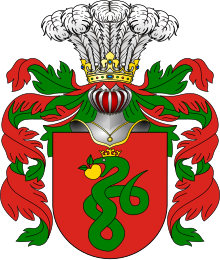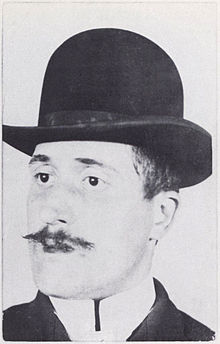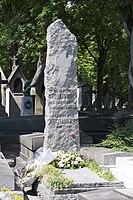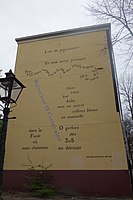Guillaume Apollinaire
Guillaume Apollinaire | |
|---|---|
 Photograph of Guillaume Apollinaire in spring 1916 after a shrapnel wound to his temple | |
| Born | Wilhelm Albert Włodzimierz Apolinary Kostrowicki 26 August 1880 Rome, Italy |
| Died | 9 November 1918 (aged 38) Paris, France |
| Resting place | Père Lachaise Cemetery, Paris |
| Occupation |
|
| Literary movement | Cubism, Surrealism, Orphism |
| Signature | |

Guillaume Apollinaire (/əpɒlɪˈnɛər/; French: [ɡijom apɔlinɛʁ]; born Kostrowicki;[a] 26 August 1880 – 9 November 1918) was a French poet, playwright, short story writer, novelist and art critic of Polish descent.
Apollinaire is considered one of the foremost poets of the early 20th century, as well as one of the most impassioned defenders of Cubism and a forefather of Surrealism. He is credited with coining the term "Cubism"[1] in 1911 to describe the emerging art movement, the term Orphism in 1912, and the term "Surrealism" in 1917 to describe the works of Erik Satie. He wrote poems without punctuation, in his attempt to be resolutely modern in both form and subject.[2] Apollinaire wrote one of the earliest Surrealist literary works, the play The Breasts of Tiresias (1917), which became the basis for Francis Poulenc's 1947 opera Les mamelles de Tirésias.
Influenced by Symbolist poetry in his youth, he was admired during his lifetime by the young poets who later formed the nucleus of the Surrealist group (Breton, Aragon, Soupault). He revealed very early on an originality that freed him from any school of influence and made him one of the precursors of the literary revolution of the first half of the 20th century. His art is not based on any theory, but on a simple principle: the act of creating must come from the imagination, from intuition, because it must be as close as possible to life, to nature, to the environment, and to the human being.
Apollinaire was also active as a journalist and art critic for Le Matin, L'Intransigeant, L'Esprit nouveau, Mercure de France, and Paris Journal. In 1912 Apollinaire cofounded Les Soirées de Paris, an artistic and literary magazine.
Two years after being wounded in World War I, Apollinaire died during the Spanish flu pandemic of 1918 and was recognized as "Fallen for France" (Mort pour la France) because of his commitment during the war.[3]
Life
[edit]Family and early life
[edit]
Wilhelm Albert Włodzimierz Apolinary Kostrowicki was born in Rome, Italy, and was raised speaking French, Italian, and Polish.[4] He emigrated to France in his late teens and adopted the name Guillaume Apollinaire. His mother, born Angelika Kostrowicka, was a Polish-Lithuanian noblewoman born near Navahrudak, Grodno Governorate (former Grand Duchy of Lithuania, present-day Belarus). His maternal grandfather participated in the 1863 uprising against occupying Russia and had to emigrate when the uprising failed.[5] Apollinaire's father is unknown but may have been Francesco Costantino Camillo Flugi d'Aspermont (born 1835), a Graubünden aristocrat who disappeared early from Apollinaire's life. Francesco Flugi d'Aspermont was a nephew of Conradin Flugi d'Aspermont (1787–1874), a poet who wrote in Ladin Putèr (an official language dialect of Switzerland spoken in Upper Engadin), and perhaps also descendant of the Minnesänger Oswald von Wolkenstein (born c. 1377, died 2 August 1445; see Les ancêtres Grisons du poète Guillaume Apollinaire at Geneanet).
Paris
[edit]Apollinaire eventually moved from Rome to Paris in 1900[6] and became one of the most popular members of the artistic community of Paris (both in Montmartre and Montparnasse). His friends and collaborators in that period included Pablo Picasso, Henri Rousseau, Gertrude Stein, Max Jacob, André Salmon, André Breton, André Derain, Faik Konitza, Blaise Cendrars, Giuseppe Ungaretti, Pierre Reverdy, Alexandra Exter, Jean Cocteau, Erik Satie, Ossip Zadkine, Marc Chagall, Marcel Duchamp and Jean Metzinger. He became romantically involved with Marie Laurencin, who is often identified as his muse. While there, he dabbled in anarchism and spoke out as a Dreyfusard in defense of Dreyfus's innocence.[7]
Metzinger painted the first Cubist portrait of Apollinaire. In his Vie anecdotique (16 October 1911), the poet proudly writes: "I am honoured to be the first model of a Cubist painter, Jean Metzinger, for a portrait exhibited in 1910 at the Salon des Indépendants." It was not only the first Cubist portrait, according to Apollinaire, but it was also the first great portrait of the poet exhibited in public, prior to others by Louis Marcoussis, Amedeo Modigliani, Mikhail Larionov and Picasso.[8]

In 1911 he joined the Puteaux Group, a branch of the Cubist movement soon to be known as the Section d'Or. The opening address of the 1912 Salon de la Section d'Or—the most important pre-World War I Cubist exhibition—was given by Apollinaire.[9][10]
On 7 September 1911, police arrested and jailed him on suspicion of aiding and abetting the theft of the Mona Lisa and a number of Egyptian statuettes from the Louvre,[4][11] but released him a week later. The theft of the statues had been committed in 1907 by a former secretary of Apollinaire, Honoré Joseph Géry Pieret, who had recently returned one of the stolen statues to the French newspaper the Paris-Journal.[12] Apollinaire implicated his friend Picasso, who had bought Iberian statues from Pieret, and who was also brought in for questioning in the theft of the Mona Lisa, but he was also exonerated.[13][12] The theft of the Mona Lisa was perpetrated by Vincenzo Peruggia, an Italian house painter who acted alone and was only caught two years later when he tried to sell the painting in Florence.
Cubism
[edit]
Apollinaire wrote the preface for the first Cubist exposition outside of Paris; VIII Salon des Indépendants, Brussels, 1911.[14] In an open-handed preface to the catalogue of the Brussels Indépendants show, Apollinaire stated that these 'new painters' accepted the name of Cubists which has been given to them. He described Cubism as a new manifestation and high art [manifestation nouvelle et très élevée de l'art], not a system that constrains talent [non-point un système contraignant les talents], and the differences which characterize not only the talents but even the styles of these artists are an obvious proof of this.[15][16] The artists involved with this new movement, according to Apollinaire, included Pablo Picasso (who represented Apollinaire in his Three Musicians painting), Georges Braque, Jean Metzinger, Albert Gleizes, Robert Delaunay, Fernand Léger, and Henri Le Fauconnier.[17] By 1912 others had joined the Cubists: Jacques Villon, Marcel Duchamp, Raymond Duchamp-Villon, Francis Picabia, Juan Gris, and Roger de La Fresnaye, among them.[15][18][19][20]

Orphism
[edit]The term Orphism was coined by Apollinaire at the Salon de la Section d'Or in 1912, referring to the works of Robert Delaunay and František Kupka. During his lecture at the Section d'Or exhibit Apollinaire presented three of Kupka's abstract works as perfect examples of pure painting, as anti-figurative as music.[19]
In Les Peintres Cubistes, Méditations Esthétiques (1913) Apollinaire described Orphism as "the art of painting new totalities with elements that the artist does not take from visual reality, but creates entirely by himself. [...] An Orphic painter's works should convey an untroubled aesthetic pleasure, but at the same time a meaningful structure and sublime significance. According to Apollinaire Orphism represented a move towards a completely new art-form, much as music was to literature.[21]
Surrealism
[edit]The term Surrealism was first used by Apollinaire concerning the ballet Parade in 1917. The poet Arthur Rimbaud wanted to be a visionary, to perceive the hidden side of things within the realm of another reality. In continuity with Rimbaud, Apollinaire went in search of a hidden and mysterious reality. The term "surrealism" appeared for the first time in March 1917 (Chronologie de Dada et du surréalisme, 1917) in a letter by Apollinaire to Paul Dermée: "All things considered, I think in fact it is better to adopt surrealism than supernaturalism, which I first used" [Tout bien examiné, je crois en effet qu'il vaut mieux adopter surréalisme que surnaturalisme que j'avais d'abord employé].[22]
He described Parade as "a kind of surrealism" (une sorte de surréalisme) when he wrote the program note the following week, thus coining the word three years before Surrealism emerged as an art movement in Paris.[23]
World War I and death
[edit]Apollinaire served as an infantry officer in World War I and, in 1916, received a serious shrapnel wound to the temple, from which he would never fully recover.[6] He wrote Les Mamelles de Tirésias while recovering from this wound. During this period he coined the word "Surrealism" in the programme notes for Jean Cocteau's and Erik Satie's ballet Parade, first performed on 18 May 1917. He also published an artistic manifesto, L'Esprit nouveau et les poètes. Apollinaire's status as a literary critic is most famous and influential in his recognition of the Marquis de Sade, whose works were for a long time obscure,[citation needed] yet arising in popularity as an influence upon the Dada and Surrealist art movements going on in Montparnasse at the beginning of the twentieth century as, "The freest spirit that ever existed."[citation needed]
The war-weakened Apollinaire died at the age of 38 on 9 November 1918 of influenza during the Spanish flu pandemic of 1918 ravaging Europe at the time, two years after being wounded in World War I.[6] Due to his military service for the duration of the war, he was declared to have "Died for France" (Mort pour la France) by the French government.[3] He was interred in the Père Lachaise Cemetery, Paris.
Works
[edit]In 1900 he wrote his first novel Mirely, ou le petit trou pas cher (pornographic), which was eventually lost.[6] Apollinaire's first collection of poetry was L'enchanteur pourrissant (1909), but Alcools (1913) established his reputation. The poems, influenced in part by the Symbolists, juxtapose the old and the new, combining traditional poetic forms with modern imagery. In 1913, Apollinaire published the essay Les Peintres Cubistes, Méditations Esthétiques on the Cubist painters, a movement which he helped to define. He also coined the term orphism to describe a tendency towards absolute abstraction in the paintings of Robert Delaunay and others. In 1917, Apollinaire produced Peintures de Léopold Survage; Dessins et aquarelles d’Irène Lagut (Paintings by Léopold Survage; Drawings and Watercolors by Irène Lagut), which is included in the permanent collection of Pérez Art Museum Miami, in the United States.[24]
In 1907 Apollinaire published the well-known erotic novel, The Eleven Thousand Rods (Les Onze Mille Verges).[25][26] Officially banned in France until 1970, various printings of it circulated widely for many years. Apollinaire never publicly acknowledged authorship of the novel. Another erotic novel attributed to him was The Exploits of a Young Don Juan (Les exploits d'un jeune Don Juan), in which the 15-year-old hero fathers three children with various members of his entourage, including his aunt.[27][28] Apollinaire's gift to Picasso of the original 1907 manuscript was one of the artist's most prized possessions.[29] The book was made into a movie in 1986.
Shortly after his death, Mercure de France published Calligrammes, a collection of his concrete poetry (poetry in which typography and layout adds to the overall effect), and more orthodox, though still modernist poems informed by Apollinaire's experiences in the First World War and in which he often used the technique of automatic writing.
In his youth Apollinaire lived for a short while in Belgium, mastering the Walloon dialect sufficiently to write poetry, some of which has survived.
-
A Calligramme by Guillaume Apollinaire[30]
-
Apollinaire's grave in Père Lachaise Cemetery
-
Poem by Apollinaire on a wall in Leiden
Poetry
[edit]- L'enchanteur pourrissant (1909). The Enchanter Rotting
- Le Bestiaire ou Cortège d'Orphée (1911)
- Alcools (1913)
- Vitam impendere amori (1917)
- Calligrammes, poèmes de la paix et de la guerre 1913–1916 (1918) (published shortly after Apollinaire's death)
- Il y a... (1925) Albert Messein
- Julie ou la rose (1927)
- Ombre de mon amour (1947). Poems addressed to Louise de Coligny-Châtillon
- Poèmes secrets à Madeleine (1949). Pirated edition
- Le Guetteur mélancolique (1952). Previously unpublished works
- Poèmes à Lou (1955)
- Soldes (1985). Previously unpublished works
- Et moi aussi je suis peintre (2006). Album of drawings for Calligrammes, from a private collection
Novels
[edit]- Mirely ou le Petit Trou pas cher (1900). Mirely, or The Cheap Little Hole (unpublished)
- Que faire ? (1900). What to Do?
- Les Onze Mille Verges ou les Amours d'un hospodar (1907). The Eleven Thousand Rods; The Debauched Hospodar
- Les Exploits d'un jeune Don Juan (1911). The Amorous Exploits of a Young Rakehell, trans. Reaves Tessor (1959)
- La Rome des Borgia (1914). The Rome of the Borgias
- La Fin de Babylone (1914). The Fall of Babylon
- Les Trois Don Juan (1915). The Three Don Juans
- La Femme assise (1920). The Sitting Woman
Short story collections
[edit]- L'Hérèsiarque et Cie (1910). The Heresiarch and Co., trans. Rémy Inglis Hall (1965)[31]
- Le Poète assassiné (1916). The Poet Assassinated, trans. Matthew Josephson (1923, title story);[32] trans. Ron Padgett (1968, unabridged)[33]
- Les Épingles (1928). The Pins
Plays
[edit]- Les Mamelles de Tirésias (1917). The Breasts of Tiresias
- La Bréhatine (1917). Screenplay (collaboration with André Billy)
- Couleurs du temps (1918)
- Casanova (published 1952)
Articles
[edit]- Le Théâtre italien, illustrated encyclopedia, 1910
- Preface, Catalogue of 8th Salon annuel du Cercle d'art Les Indépendants, Musée moderne de Bruxelles, 10 June – 3 July 1911.
- La Vie anecdotique, Chroniques dans Le Mercure de France, 1911–1918
- Pages d'histoire, chronique des grands siècles de France, chronicles, 1912
- Les Peintres Cubistes, Méditations Esthétiques, 1913
- La Peinture moderne, 1913
- L'Antitradition futuriste, manifeste synthèse, 1913
- Jean Metzinger à la Galerie Weill, Chroniques d'art de Guillaume Apollinaire, L'Intransigeant, Paris Journal, 27 May 1914
- Case d'Armons, 1915
- L'esprit nouveau et les poètes, 1918
- Le Flâneur des Deux Rives, chronicles, 1918
Translations into English
[edit]- The Poet Assassinated, trans. Matthew Josephson (The Broom Publishing, 1923)
- Selected Writings, trans. Roger Shattuck (New Directions, 1948)
- Alcools: Poems 1898–1913, trans. Walter Meredith (Doubleday, 1964)
- Alcools, trans. Anne Hyde Greet (University of California Press, 1965)
- Selected Poems, trans. Oliver Bernard (Penguin, 1965; expanded, bilingual edition, Anvil Press, 1986)
- The Heresiarch and Co., trans. Rémy Inglis Hall (1965), published in the UK as The Wandering Jew and Other Stories (1967)[34]
- The Poet Assassinated, trans. Ron Padgett (Holt, Rinehart & Winston, 1968)
- Calligrams, trans. Anne Hyde Greet (Unicorn Press, 1970)[35]
- Apollinaire on Art: Essays and Reviews, 1902–1918, trans. Susan Suleiman (1972)
- Zone, trans. Samuel Beckett (Dolmen Press, 1972)
- Alcools: Poems, trans. Donald Revell (Wesleyan University Press, 1995)
- The Self-Dismembered Man: Selected Later Poems, trans. Donald Revell (Wesleyan University Press, 2004)
- The Little Auto, trans. Beverley Bie Brahic (CB editions, 2012)
- "Zone", trans. David Lehman, in Virginia Quarterly Review (2013)[36]
- Zone: Selected Poems, trans. Ron Padgett (New York Review Books, 2015)
- Selected Poems, trans. Martin Sorrell (Oxford University Press, 2015)
In popular culture
[edit]- French composer Francis Poulenc has set Apollinaire's poems to music in his five-part song cycle Banalités (1940), which in turned inspired Pink Martini's song Sympathique (je ne veux pas travailler in 1997.
- Dutch composer Marjo Tal set some of Apollinaire’s poetry to music.[37]
- French composer Denise Roger set Apollinaire’s poetry to music.[38]
- Apollinaire is played by Seth Gabel in the 2018 television series Genius, which focuses on the life and work of Pablo Picasso.
See also
[edit]- La Chanson du mal-aimé, oratorio by Léo Ferré on Apollinaire's eponymous poem (from Alcools)
- Monostich
- Prix Guillaume Apollinaire
Notes
[edit]- ^ His full birth name in Polish is Wilhelm-Albert-Włodzimierz-Aleksander-Apolinary Kostrowicki (Belarusian: Гіём-Альберт-Уладзімір-Аляксандр-Апалінарый Кастравіцкі) of the Wąż coat of arms.
References and sources
[edit]- References
- ^ Daniel Robbins, 1964, Albert Gleizes 1881–1953, A Retrospective Exhibition, Published by The Solomon R. Guggenheim Foundation, New York, in collaboration with Musée National d'Art Moderne, Paris, Museum am Ostwall, Dortmund
- ^ Judge, Harry George; Toyne, Anthony, eds. (1985–1993). Oxford illustrated encyclopedia. Oxford University Press. p. 18. ISBN 0-19-869129-7. OCLC 11814265.
- ^ a b Catherine Moore, Mark Moore, Guillaume Apollinaire official website, Biographie: Chronologie, Western Illinois University
- ^ a b "Газетные "старости" (Архив)". Starosti.ru. 9 January 1907. Retrieved 6 December 2011.
- ^ "How Apollinaire's Polish Roots Impacted His Life & Work". Culture.pl. Retrieved 4 March 2022.
- ^ a b c d John Baxter (10 February 2009). Carnal Knowledge: Baxter's Concise Encyclopedia of Modern Sex. HarperCollins. p. 13. ISBN 978-0-06-087434-6. Retrieved 24 December 2011.
- ^ Claude Schumacher, Alfred Jarry and Guillaume Apollinaire, Modern Dramatists, Macmillan International Higher Education, 1984, pp. 4, 14, 23, 148, 168, ISBN 1349173282
- ^ Jean Metzinger, 1910, Portrait of Guillaume Apollinaire, Christie's Paris, 2007.
- ^ La Section d'Or, Numéro spécial, 9 Octobre 1912.
- ^ The History and Chronology of Cubism Archived 14 March 2013 at the Wayback Machine, p. 5.
- ^ "Un homme de lettres connu est arrêté comme recéleur", Le Petit Parisien, 9 September 1911 (in French).
- ^ a b Krauss, Rosalind (2016). "1911". In Hal Foster; Rosalind E. Krauss; Yve-Alain Bois; B. H. D. Buchloh; David Joselit (eds.). Art since 1900: modernism, antimodernism, postmodernism (3rd ed.). London: Thames & Hudson. p. 118. ISBN 978-0-500-23953-7. OCLC 958112079.
- ^ Richard Lacayo, "Art's Great Whodunit: The Mona Lisa Theft of 1911", Time, 27 April 2009.
- ^ Préface, in Catalogue du 8e Salon annuel du Cercle d'art Les Indépendants, Musée moderne de Bruxelles, 10 June – 3 July 1911.
- ^ a b Douglas Cooper, 1971, Douglas Cooper, The Cubist Epoch, Los Angeles County Museum of Art, Metropolitan Museum of Art, New York, 1970, p. 97
- ^ Françoise Roberts-Jones, Chronique d'un musée: Musée royal des beaux-arts de Belgique, Bruxelles.
- ^ Daniel Robbins, 1985, Jean Metzinger in Retrospect, Jean Metzinger: At the Center of Cubism, University of Iowa Museum of Art, Iowa City, J. Paul Getty Trust, University of Washington Press, pp. 9–23
- ^ Apollinaire, Guillaume (7 August 1913). Les peintres cubistes. Première série. Tous les arts. Eugène Figuière et cie, éditeurs – via library.metmuseum.org Library Catalog.
- ^ a b Guillaume Apollinaire, Les Peintres Cubistes (The Cubist Painters) published in 1913, Peter Read (Translator), University of California Press, 2004
- ^ Herschel Browning Chipp, Peter Selz, Theories of Modern Art: A Source Book by Artists and Critics, University of California Press, 1968, pp. 221–248, ISBN 0-520-01450-2
- ^ Hajo Düchting, Orphism, MoMA, From Grove Art Online, 2009 Oxford University Press.
- ^ Jean-Paul Clébert, Dictionnaire du surréalisme, A.T.P. & Le Seuil, Chamalières, p. 17, 1996.
- ^ Hargrove, Nancy (1998). "The Great Parade: Cocteau, Picasso, Satie, Massine, Diaghilev – and T.S. Eliot". Journal for the Interdisciplinary Study of Literature 31 (1)
- ^ "Peintures de Léopold Survage; Dessins et aquarelles d'Irène Lagut (Paintings by Léopold Survage; Drawings and Watercolors by Irène Lagut) • Pérez Art Museum Miami". Pérez Art Museum Miami. Retrieved 27 September 2023.
- ^ Patrick J. Kearney, A History of Erotic Literature, 1982, pp. 163–164
- ^ Karín Lesnik-Oberstein, The last taboo: women and body hair, Manchester University Press, 2006, ISBN 0-7190-7500-9, p. 94
- ^ Neil Cornwell, The Absurd in Literature, Manchester University Press, 2006, ISBN 0-7190-7410-X, pp. 86–87
- ^ Roger Shattuck, The Banquet Years: the arts in France, 1885–1918: Alfred Jarry, Henri Rousseau, Erik Satie, Guillaume Apollinaire, Doubleday, 1961, p. 268.
- ^ Golding, John (1994). Visions of the Modern. University of California Press. p. 109. ISBN 0520087925.
- ^ Action: Cahiers Individualistes De Philosophie Et D’art, October 1920, Blue Mountain Project, Princeton University
- ^ Apollinaire, Guillaume (1965). The Heresiarch and Co. Internet Archive. Garden City, NY, Doubleday.
- ^ Apollinaire, Guillaume (1923). The poet assassinated / y Guillaume Apollinaire ; translated from the French with a biographical notice and notes by Matthew Josephson. Getty Research Institute. New York : Broom Pub.
- ^ Apollinaire, Guillaume (1985). The poet assassinated : and other stories. Internet Archive. Manchester : Carcanet. ISBN 978-0-85635-548-6.
- ^ Apollinaire, Guillaume (1967). The Wandering Jew, and other stories;. Internet Archive. London: Hart-Davis.
- ^ Apollinaire, Guillaume (1980). Calligrammes : poems of peace and war (1913–1916). Internet Archive. Berkeley: University of California Press. ISBN 978-0-520-01968-3.
- ^ Lehman, David (Spring 2013). "Apollinaire's "Zone"". Virginia Quarterly Review.
- ^ trilobiet, acdhirr for. "Marjo Tal". www.forbiddenmusicregained.org. Retrieved 4 September 2021.
- ^ "Denise Isabelle Roger Song Texts | LiederNet". www.lieder.net. Retrieved 8 May 2024.
- Sources
- Apollinaire, Marcel Adéma, 1954
- Apollinaire, Poet among the Painters, Francis Steegmuller, 1963, 1971, 1973
- Apollinaire, M. Davies, 1964
- Guillaume Apollinaire, S. Bates, 1967
- Guillaume Apollinaire, P. Adéma, 1968
- The Banquet Years, Roger Shattuck, 1968
- Apollinaire, R. Couffignal, 1975
- Guillaume Apollinaire, L.C. Breuning, 1980
- Reading Apollinaire, T. Mathews, 1987
- Guillaume Apollinaire, J. Grimm, 1993
External links
[edit]- Works by or about Guillaume Apollinaire at the Internet Archive
- Works by Guillaume Apollinaire at LibriVox (public domain audiobooks)

- Reading Apollinaire’s ‘Vendémiaire’, Cordite Poetry Review 2014
- "Official" site hosted by Western Illinois University
- Becker, Annette: Apollinaire, Guillaume, in: 1914–1918-online. International Encyclopedia of the First World War.
- Audio recordings of Apollinaire reading his poems "Le Pont Mirabeau", "Marie" and "Le Voyageur"
- English verse translation of Le Pont Mirabeau
- Les exploits d'un jeune Don Juan at IMDb
- Guillaume Apollinaire (poems in French and English)
- Les onze mille verges an e-book (in French)
- A digital rendition of Apollinaire's best known poem, "Il Pleut"
- Guillaume Apollinaire
- 1880 births
- 1918 deaths
- 19th-century French novelists
- 20th-century French novelists
- 20th-century French dramatists and playwrights
- 20th-century French poets
- 20th-century French short story writers
- Burials at Père Lachaise Cemetery
- French cubist artists
- Deaths from the Spanish flu pandemic in France
- French art critics
- French erotica writers
- French male dramatists and playwrights
- French male poets
- French military personnel killed in World War I
- French people of Polish descent
- French surrealist writers
- French World War I poets
- Modernist theatre
- Modernist writers
- Orphism (art)
- Surrealist dramatists and playwrights
- Writers from Rome
- People of Montmartre
- Naturalized citizens of France
- French prisoners and detainees
- Prisoners and detainees of France
- Dreyfusards
- 19th-century pseudonymous writers
- 20th-century pseudonymous writers

![A Calligramme by Guillaume Apollinaire[30]](http://upload.wikimedia.org/wikipedia/commons/thumb/f/f9/Guillaume_Apollinaire%2C_Po%C3%A8me_Calligramme.jpg/149px-Guillaume_Apollinaire%2C_Po%C3%A8me_Calligramme.jpg)


